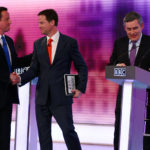 It’s not immediately clear just how valuable political debates are in modern democracies, but a live televised debate is a standard feature of most political campaigns today. You suspect the media like to portray themselves as impartial hosts of such discussions, but a recent study from the University of Arkansas shows how even seemingly minor changes can influence how viewers perceive candidates.
It’s not immediately clear just how valuable political debates are in modern democracies, but a live televised debate is a standard feature of most political campaigns today. You suspect the media like to portray themselves as impartial hosts of such discussions, but a recent study from the University of Arkansas shows how even seemingly minor changes can influence how viewers perceive candidates.
The study examined the primary debates for both the Democratic and Republican Party presidential candidates during the 2016 primaries, and the authors suggest that both Donald Trump and Hillary Clinton received favorable visual framing, such as the amount of camera time and solo shots.
“Although the questions asked and the speaking time given to the candidates can certainly influence how the candidates convey themselves and their policy positions, perhaps a more primal, subtle and pervasive means by which the media affects public perceptions of candidates is how they visually depict each candidate,” they say.
In the frame
The debates for both parties were analyzed frame-by-frame, with the researchers monitoring the camera time, the average shot time and the type of shot each candidate was given by the production team at the broadcaster. The hypothesis was that the way producers depicted candidates during the broadcast gave a subtle message to viewers as to the leadership abilities and traits of certain candidates. For instance, more time in solo or side-by-side shots was seen as preferential to being captured alongside a host of other candidates.
During the Republican debates, Donald Trump secured the most camera time by far during the debates, with Jeb Bush a distant second. The rankings for screen time matched those in the polls at the time, with the gap between Bush and the rest even greater than between he and Trump.
What’s more, Trump was also disproportionately in solo screen shots versus group shots, with most seeming to frame him as the leader or the main candidate for leadership.
“The visual framing findings in this study suggest that in debates with numerous candidates on stage, there were big winners and big losers,” the authors continue. “During the early debates of the 2016 presidential election, the big winner was Donald Trump.”
A similar picture emerged when analyzing the Democratic debates, with Hillary Clinton securing the most screen time, followed by Bernie Sanders. As with Trump, Clinton was rarely shown in shots with multiple candidates, even though the Democratic campaign had fewer candidates.
“If seeing is believing, then who chooses what and who we see, and how we see them, has enormous influence and responsibility for a functioning republic,” the authors conclude.